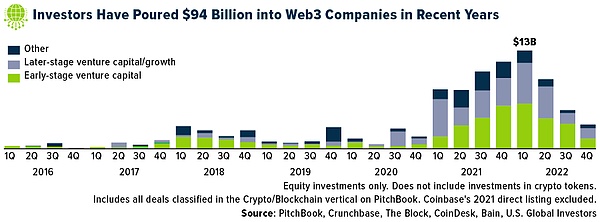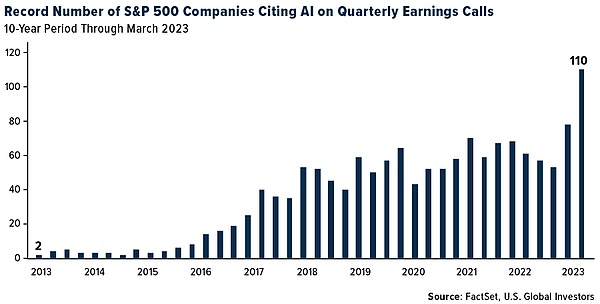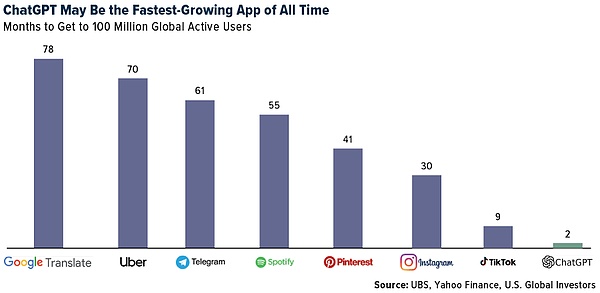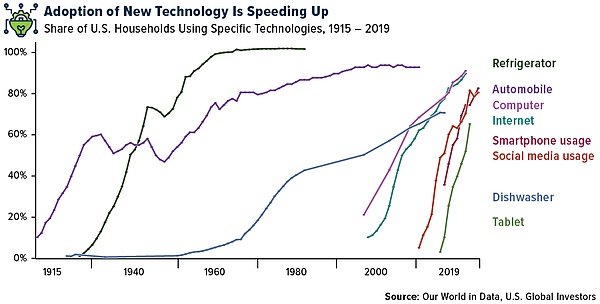
However, as Deloitte points out, the plummeting prices of digital assets have some similarities to the burst of the internet bubble in the early 2000s. Just as the internet became an integral part of life and work over time, the transformative potential of Web3 may continue to exist, attracting venture capital and private equity investors.
03. Artificial Intelligence, U.S. Companies and the Rising Stars of the Metaverse
Interest in artificial intelligence (AI) is also growing, as evidenced in the U.S. corporate world. According to FactSet’s analysis of earnings conference calls for the first quarter of 2023, the number of S&P 500 companies discussing artificial intelligence has increased significantly. During this period, 110 companies mentioned artificial intelligence, a significant increase from the five-year average of 57 and the ten-year average of 34.

In the same direction, real-time 3D virtual applications developed by companies such as Meta, Roblox, and Apple are expected to drive increased spending on AI servers. Spending on AI servers is expected to grow at a rate of 19% per year until 2032, according to forecasts. This is due to the increasing demand for generative artificial intelligence, with popular applications such as ChatGPT and Midjourney among the main reasons.
“Generative artificial intelligence” refers to applications that can create unique content based on simple prompts submitted by users. Earlier this year, ChatGPT became the fastest-growing application in history, attracting 100 million users in just two months after its launch.

In order to operate efficiently, these metaverse applications will require advanced graphics and artificial intelligence processors, which will increase investment in high-performance AI chips from companies such as NVIDIA and AMD, as well as data center operators such as HIVE Blockchain Technologies. According to Bloomberg Intelligence, AI server spending could account for nearly 30% of total workload spending by 2032, compared to a proportion of around 15% in 2022, a significant increase.
04. Generative Artificial Intelligence, a Trillion-Dollar Industry
But in the “real world,” where can generative AI be used? McKinsey & Company found 63 AI applications in 16 business functions. If applied, generative AI would create between $2.6 trillion and $4.4 trillion in economic value annually. This would increase the potential value of non-generative AI and analytics, currently valued at $11 trillion to $17.7 trillion, by 15% to 40%.
Goldman Sachs is even more optimistic. According to the bank, the progress of generative AI could have a significant impact on the global economy, with global GDP expected to increase by 7% (equivalent to nearly $7 trillion) over the next decade, and a 1.5% increase in productivity growth.
As an example, Amazon Web Services (AWS) announced last week the launch of the AWS Generative AI Innovation Center, a $100 million initiative aimed at helping customers develop and implement generative AI solutions. This is part of the company’s strategy to expand global accessibility to generative AI for its customers and partners.
05. People will adopt new technologies faster
It can be understood that some readers may be confused, but it is worth remembering that technology cycles usually occur every 10-15 years. Web3, AI, and digital assets are no exception.
Adopting Web3, AI, and blockchain assets more widely is certainly not easy. The main obstacle may be the user experience. For example, the process of setting up a crypto wallet can be quite complex and cumbersome, and standard web browsers may require additional plugins to support Web3 functionality.
To promote mass adoption, Web3 needs to provide a user-friendly interface, just as the transition from Web1 to the current more interactive version of the Internet did. This transition may be led by major tech companies like Meta, who understand the potential benefits of simplifying Web3 for ordinary users.
The good news is that people seem to be getting better at accepting new technologies. A study by MIT’s Technology Review in 2013 confirmed this trend. For example, it took half a century for the telephone to become a common device in American households, while smartphones reached a 40% adoption rate in just 10 years.

Similarly, the progress in digital transformation is expected to be very rapid. According to a survey conducted last summer, 75% of retailers plan to accept digital currency as a payment method in the next two years. Andreessen Horowitz predicts that blockchain technology as the cornerstone of Web3 will lead to a new digital era and may have one billion global users by 2031. By comparison, the Internet did not reach one billion users until 2005.
Like what you're reading? Subscribe to our top stories.
We will continue to update Gambling Chain; if you have any questions or suggestions, please contact us!